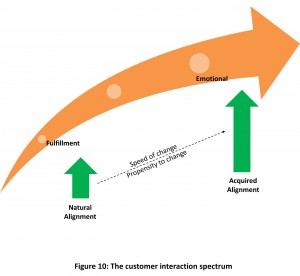Customer Experience design is often considered to be at the point of interaction. That’s why we see so many customer service trainings being conducted for customer facing teams. Some common scenarios are:
- Handle a customer’s call
- Process service requests at a branch
- Deliver a product and orient customers
- Train customers on how to use a product
- Provide a personalized website or mobile experience
- Set up a proactive email automation program
These bottom-up approaches are indeed required. They are important for innovation and individual enterprise to grow and flourish. They make employees passionate about the work they are doing. And initiatives such as these keep the ball rolling by making incremental innovations, instead of trying to execute a grand old strategy.
However, these initiatives must be supported by a grand old strategy to prevent us from running into inconsistent customer experiences between the multiple touch-points we all have with our customers. That’s true even for small businesses where the biggest limitation is time and resources.
 In my book, I laid out 5 core principle of competing in a digital world. Of these, the principle of customer interaction can be used effectively to create the right CX framework. Other principles are important too but our grand old strategy can be reasonably jump-started by the use of this principle alone.
In my book, I laid out 5 core principle of competing in a digital world. Of these, the principle of customer interaction can be used effectively to create the right CX framework. Other principles are important too but our grand old strategy can be reasonably jump-started by the use of this principle alone.
Basically, the principle states that since we interact with customers at both emotional (advertising) and physical (product performance and interactions) level, our approach must be oriented to complement the two ends of the customer interaction spectrum. And to be able to do that, we must think of:
- The life cycle – from awareness to purchase to post purchase engagement
- The mediums – through advertisements to education to promotions to customer service
- The channels – phone, email, in-person, in-store etc.
It looks complicated. But its as simple as taking the brand message and weaving it in with the customer expectation at the right stage in life cycle, medium and channel. Here are some examples:
- A cable company competing with incumbent DSL services touts its network of wi-fi hot spots. But customers struggle to use the wi-fi in many locations (various reasons). And their telecom provider constantly tells customers about the slow browsing speed at home. This is a classic case of CX dissonance, and how customers believe what they constantly hear. What we claim is not being reinforced by the physical experience. How do we mitigate this by messaging, CX changes and even strategic developments of the product?
- When we visit a branch, we often finish our transaction at the teller, and then we’re off. And if they do initiate a dialog after that, its to sell a product or service, and hand us a brochure. Although, our financial well-being is something that banks have always touted on billboards, advertisements and on signs inside the branch. it’s so surprising that they don’t try to help us with our financial management without the strong sales push. How should we try to resolve this CX dissonance?
Its obvious that CX initiatives at both individual interactions as well as at the corporate level are needed to support each other. The individual initiatives can only do so much. They can resolve a “known pain” with a business scenario. Every business scenario has exceptional flows when things don’t go as expected. And that’s where the human enterprise and empathy really shines. Think of the associate who goes out of the way to help you with a return or a claim. Individual initiatives create a lasting impact here.
However, individual initiatives cannot be the anchor for our CX strategy. CX is to be enabled by a top down agenda of the right positioning, and enabling of touch points to support that positioning. And realizing the CX vision often needs product improvements and other overreaching corporate changes too. A simple step towards that journey may be to educate all our touch-points on how they are all working together to create the desired effect, and how interconnected they are.
